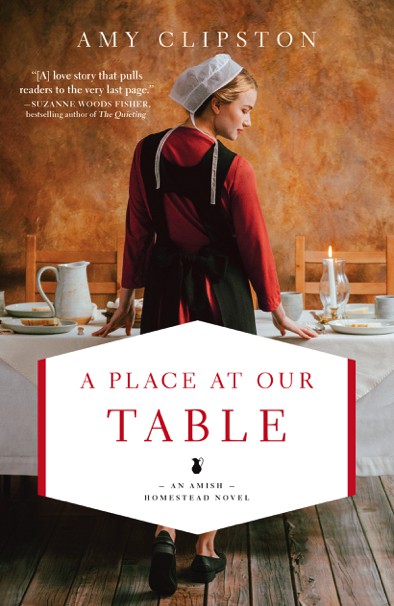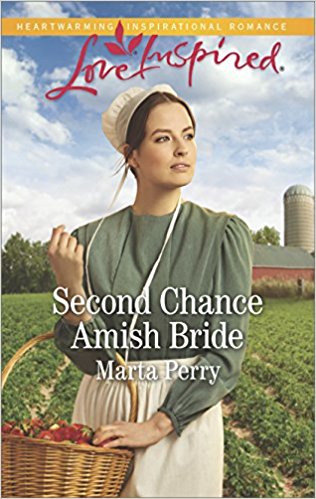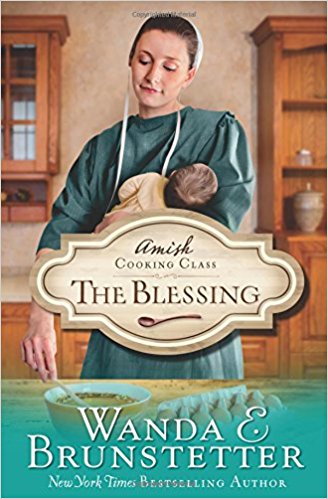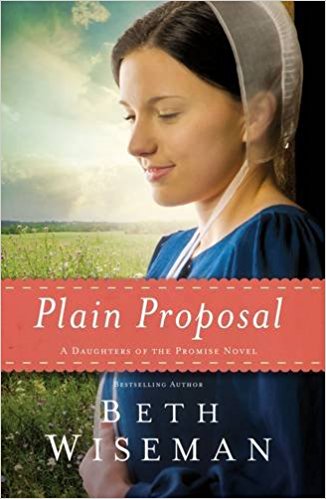Kayla Dienner is a sweet young woman who works as a waitress at her family’s restaurant. She was pretty close to a guy named Abram, but he broke up with her shortly after her firefighter brother died while on a call. (What a jerk, right?) Jamie is a firefighter who is sweet on Kayla. See how his vocation is an obstacle to their relationship? Kayla and Jamie are two great young people…will they be able to make and build a connection? Continue Reading
Novel
Amish, Amish Romance, Amy Clipston
Have you ever loved someone who didn’t love you back in the same way? Have you ever gotten what you wanted at the exact wrong time and wondered how you would cope? Have you ever felt mistreated by someone you love and hoped they would come around before you take off? Continue Reading
Novella
Amish, Amish Romance, Amy Lillard
Caleb is not experiencing one of the high points of his life. His estranged wife died, leaving him to care for two kids. He broke his leg in an accident and cannot properly tend to his dairy farm. And worst of all, his wife’s sister has arrived from her own Amish enclave to help out in the household. Caleb isn’t a big fan of Jessie; perhaps she reminds him of Alice, the wife who abandoned the family before returning when she was close to death.
Jessie did her best to reach out to her sister, but failed. And she has a secret of her own: she had a huge crush on Caleb before Alice, the prettier sister, captured his attention. Spending time around him is painful, even all these years later. (Purchase the book from the publisher, Kobo, Barnes and Noble, or Amazon. Here’s her Facebook page and web site.) Continue Reading
Novel
Amish, Amish inspirational, Romance
Several months ago, I was briefly a guest at the fictional Troyer farm, where Heidi and Lyle offer you their hospitality and their love of humanity. Their farm is a calm and peaceful place: plenty of sunshine, plenty of nature. Yes, things sometimes go wrong for the Troyers and the people around them, but there are no politics. People are focused on growing in love for others. They want to nourish their bodies, hearts, and minds.
Well, ladies and gentlemen, Heidi is teaching more of her famous cooking classes. Wanda E. Brunstetter was kind enough to chronicle what happened in her new book, Amish Cooking Class: The Blessing. Here’s the book trailer.
You can book your own return trip (or your first) to Walnut Creek by purchasing the novel from your local indie, Kobo, Barnes & Noble, or Amazon.
When the first book ended, Heidi was expecting to adopt the child of one of her students. At the beginning of this book, Kendra has changed her mind. Heidi is understandably disappointed, but decides not to dwell on her grief. The formula holds; there are six more students, including a caterer and a food critic, a wife who feels neglected, and a teenage girl whose mother took off. Do I even need to say that Heidi and her six students will have meaningful experiences that bring them closer to each other and to their faith?
The great charm of this novel (and of many Amish inspirational romances, however you wish to label them) is that the conflicts are very meaningful to the characters, but everything usually works out. The characters are sometimes cross with each other, but always in a relatable manner that doesn’t kick up too much of the reader’s own psychological pain. Ms. Brunstetter offers us a passage into another world, where we can escape…all of the things.
Ms. Brunstetter also takes her time. Her prose is always clear, and she often explains things that don’t need to be explained. I sometimes wonder what an MFA workshop might say about the prose. (MFA workshops, of course, are also known as the “Circle of Love,” so dubbed by the great Lee K. Abbott.) Some might say that there are “inefficiencies” in the prose. I contend that the prose fits the tone of the novel and the story its author is trying to tell.
Here’s an example. It’s the very first paragraph, in fact:

Loving and good-hearted workshop members may wonder:
- Do we need to know that Heidi peeled and cut the onion? Why not just say “cut?” Isn’t it a given that a person peels an onion they are going to cut and use as an ingredient?
- Is “savory” necessary? Isn’t meat loaf inherently savory?
- Do we need to know the reason Heidi is feeling the gust of wind? Do we need to know that the room is being aired out?
Another example:

- Does Heidi need to go to the window to look out the window? It’s a window; windows are generally transparent. Why couldn’t she just look?
There are a lot of examples of this kind of prose, and I make the case that the “inefficiencies” are a great benefit to the book. Ms. Brunstetter’s novel, it seems to me, has two goals, give or take:
- To tell an uplifting story that helps people in some spiritual manner. (Ms. Brunstetter seems like a kind woman, so I’m guessing she’d prefer the reader feel a Christian kind of love, but she’d take whatever she can get in that regard.)
- To transport the reader to Walnut Creek and immerse them in the Amish world and and way of life.
When you consider these goals, the “inefficiencies” are anything but. Why do Amish people use buggies instead of cars? So they can devote more thought and time to hard work and faith. (Among other reasons.) The Blessing is not the kind of book in which the author wishes to experiment with narrative or to force the reader to do a lot of work. No, Ms. Brunstetter wants the book to be a happy comfort, and her prose style helps her achieve that goal.
Amish Cooking Class: The Blessing is a welcome return to Walnut Creek. Ms. Brunstetter avoids the pitfalls of writing the second book in a series; this one is sufficiently different from the first to remain interesting though it follows the same formula. The reader finds themselves pulling for all of the characters because we can all relate to their concerns in one way or another. (We want our significant others to love us, we want to fulfill our need to nurture, we sometimes struggle with forgiving those who have abandoned us…)
There are many great writers in the Amish genre, and Ms. Brunstetter is one of those near the top. If you’ve never read in the genre, consider giving this or another of her books a try.
BONUS: Here is a great talk that Ms. Brunstetter gave to a library gathering. She is not the same kind of writer as we hear in the “MFA crowd,” and that is a good thing. She is very much a writer and storyteller, and we would all benefit from understanding more of the industry that we inhabit. (Or to which we aspire.)
Novel
Amish, Amish inspirational, Romance, Wanda E. Brunstetter
The course of true love never did run smooth, even in an Old Order Amish community. Miriam has been in love with Saul Fisher since they were children. Now they are on the cusp of adulthood, the time when young men and women must decide which paths in life they will take. Miriam expects she and Saul will marry and remain in the community. Saul, on the other hand, has a job offer from a Pittsburgh restaurant and can’t wait to leave, though it means abandoning his brothers.
Beth Wiseman very much does her job in Plain Proposal, part of her Daughters of the Promise series. Yes, the book is a romance novel, and not even the kind that features “naughty.” Yes, this is a Christian novel, and one of Ms. Wiseman’s explicit desires is to buffet the reader’s belief in Christianity. If you don’t avail yourself of these kinds of novels on occasion, you’re really missing out. Writers such as Ms. Wiseman are great because they make promises to the reader and then fulfill them. What else do you want from a storyteller? (Please consider purchasing the book through Ms. Wiseman’s web site, from your local indie store, from Kobo, from Barnes and Noble, or from Amazon.)
Okay, so because this is an Amish/romance/Christian/inspirational novel, we can be pretty sure that the book is not going to feature a worldwide alien invasion or a Silence of the Lambs situation. Still, Ms. Wiseman must find a way to fulfill her responsibility to the reader. She must give us a story in which the events matter very deeply to the characters. There must be something important at stake.
Now look what Ms. Wiseman does in Chapter One. We learn that the book is structured in such a way that there are alternating sections from the viewpoints of different characters. It’s immediately clear that Miriam and Saul fancy each other. Boooooooring. That’s not enough to make a good book, and Ms. Wiseman knows it. After we hear about the impending arrival of Miriam’s pretty Englisch cousin (potential love rival?!?!?), the author ends the chapter from Saul’s perspective thus:
But as she looked up at him with a smile that threatened to melt his resolve, he knew that he was going to do the unthinkable-date her for the summer. Then leave her in August. God, forgive me.
Oh, snap! You don’t need to be Amish to know that this is a SERIOUS situation. (And it’s a serious situation, regardless of your religion or way of life.) We don’t know Miriam or Saul very well because we’re only in Chapter One, but Ms. Wiseman sets up some very big stakes:
Miriam and Saul are both in their rumschpringe, the “running around” time in which a young person decides whether he or she wishes to be baptized into the Amish way of life permanently. Both have been running around for a while…time is running out before they must make a decision.
Miriam wants to live in the community and to marry Saul.
Saul wants to leave the community but also wants to have a sweet, romantic summer with Miriam.
These two goals are contradictory! If one of them gets what he or she wants, the other will be heartbroken!
I loved the end of Chapter One because of how succinctly and powerfully Ms. Wiseman established the stakes. I was reminded of a very different work of art: The Terminator. After Kyle Reese and the T-800 shoot up the Tech Noir nightclub around Sarah Connor, Kyle makes the stakes of the story very, very clear: “Come with me if you want to live.”
Miriam’s cousin Shelby is also a young woman, but she’s not Amish. Her parents are splitting up, and Shelby has made some poor decisions. (Unfortunately, this is an Amish/romance/inspirational-type novel, so the reader does not get any of the dirty details. I suppose Ms. Wiseman leaves it to your imagination.) As another of the book’s main characters, SHELBY NEEDS A REASON TO BE IN THE RABER HOME. SHE NEEDS TO HAVE SOME STAKE IN THE NOVEL. So the author is careful to give her one at the end of Chapter Two. Shelby writes in her diary:
…Maybe I’m being punished. I don’t know. I just know that I feel bad all the time. I want to be loved, but my heart is so empty and my faith in life, in God, is gone. I don’t have anything to live for.
So what is Shelby’s arc through the rest of the book? Of course. She’s going to find a reason to live. (It’s not a spoiler alert to reveal that God is a part of the reason.)
Ms. Wiseman’s book is a fun and quick read because she made the characters’ goals so clear, even though she puts poor Miriam and Saul through a lot of changes of minds and hearts. Even though the story and characters evolve (particularly Miriam’s mother, Rebecca!), the reader always has a firm grasp of what the characters want and why it matters to them.
Novel
Amish, Beth Wiseman, Romance
Hey, everyone. It’s time to be a little bit jealous of Wanda E. Brunstetter. But not too jealous; that would be a sin. Ms. Brunstetter has published a lot of books and has a devoted audience for her Amish inspirational romances. I know many people aren’t literary omnivores, but I love reading all kinds of books, even though I’m not exactly in the stereotypical demographic for these kinds of novels. Still, Ms. Brunstetter has a lot to teach us. More importantly, she writes fun books and fulfills every promise she makes with her books.
Check out this book trailer for the first book in The Amish Cooking Class series: The Seekers.
The novel is centered upon the farm of Lyle and Heidi Troyer. They are a proud Amish couple-but not too proud; that would be a sin-who have a beautiful place in Ohio. Lyle is an auctioneer and Heidi decides to make a little money and to share her gift with others by teaching a weekly cooking class.
I guess I’ll introduce the first lesson here…Ms. Brunstetter very wisely came up with a conceit that allows her to put a bunch of drama-prone characters together. Think about it. While Heidi Troyer is a very calm and dignified woman who has most everything figured out, she surrounds herself with people who have far more problems than she does. Ron is a Vietnam War vet who ends up camped on the Troyer property when his RV breaks down. Kendra is pregnant and her family has turned her away, not that doing so will stop the baby from arriving. Eli lost his wife and is looking for companionship. See? All of these people have discernible problems and needs. Guess what? Ms. Brunstetter allows the characters to grow and change based upon their interactions and their own internal struggles. (And maybe Heidi has her own problem that needs to be solved…)
We certainly can’t fashion every single one of our stories in this way, but creating a nexus of conflict and drama is a time-tested tactic for teasing trouble out of our characters. Here are some examples:
- Cheers, the bar from Cheers, is populated by a number of well-drawn characters who unite in one place. Each of them have their own problems and needs and the writers wring drama (and comedy) out of having all of these characters in the same place.
- Rick’s Café Américain from Casablanca is a meeting spot that facilitates conflict. Everyone goes there. The Nazis, the French, ridiculously beautiful refugees played by Ingrid Bergman…everyone. Placing everyone in the same nightclub allows the drama to blossom. (If you haven’t seen Casablanca, please do so. It’s for the best.)
- Eerie, Indiana is the new home of Marshall Teller, a town where all kinds of creepy and cool things happen. The gents who created the TV show, José Rivera and Karl Schaefer, created a place where weird and wonderful things can happen. The show could have (and should have) run forever.
Heidi’s Amish cooking class offers Ms. Brunstetter near-inexhaustible opportunities to cycle interesting characters in and out of the orbit of the Troyer kitchen. This seems to be the plan, as The Seekers is Book One of a series…
This is an Amish inspirational romance-type book, so you know there won’t be any of the flashy kinds of conflict on offer. The international spy rings, serial killers and terrorist attacks will appear in other kinds of books. Still, Ms. Brunstetter allows her characters to be unpleasant, particularly in the context of the genre and story. Ron, the Vietnam vet, repeatedly lies to the Troyers and takes advantage of their hospitality. He even steals from his hosts. Kendra made “one little mistake” and got pregnant out of wedlock. Ms. Brunstetter does not examine these themes in the same manner as writers in other genres might do, but she is still allowing her characters to misbehave and to do things that the Christian characters shouldn’t do. The principle applies to characters in all genres. On occasion, I read YA books in which the teenagers are impossibly polite and respectful of the opposite sex. Not only does this kind of attitude pose problems creating drama, but it’s also not realistic.
Those who write Amish books have a problem that is easily transferable to all other authors who include other languages in their work. The Amish are generally fluent in Pennsylvania Dutch and the language is a very important part of their culture. (As it is for every culture.) Ms. Brunstetter has an obligation to include the language in her dialogue-the characters would use these words!-but she must also ensure that the audience knows what she’s talking about. Let’s take a look at an example of how the author handles this problem:
See what she does? She italicizes the word the reader probably won’t know and then defines it in the following line of dialogue. We were already told that Lyle is married to Heidi, so we know fraa = wife. Kichlin = cookies. There are other ways to handle the problem, but this is one.
I’ve read a few of Ms. Brunstetter’s books, and The Seekers is as fun as the others. The world that the author creates, this Amish version of Ohio, is everything that her readers want it to be. It’s simple. Plain. People still have conflicts, but they resolve them calmly. (And with the help of God, as her target readers expect.)
The great strength of this book (and of so many others in the genre) is that the authors make promises to the reader and keep them. Ms. Brunstetter promises the reader in this case, that they will learn about Amish food, they will see characters solve their problems together and with the help of their religion and that the book will be a calm and unobjectionable read that has a discernible conclusion that wraps everything up. (Aside, of course, from the story strands that will likely be taken up in subsequent books.)
I don’t know how many Great Writers Steal writers have given the Amish inspirational genre a chance, but they should. A writer must have a balanced reading diet.
Novel
Amish, Amish inspirational, Romance, Shiloh Run Press, Wanda E. Brunstetter






